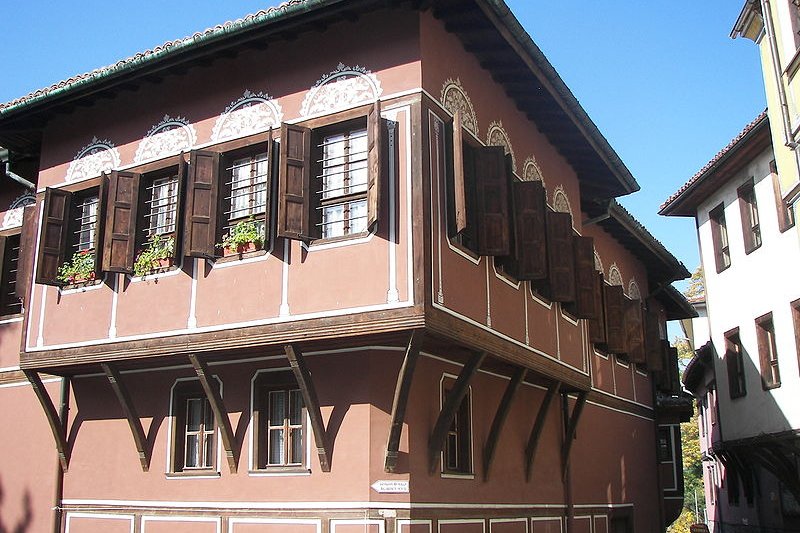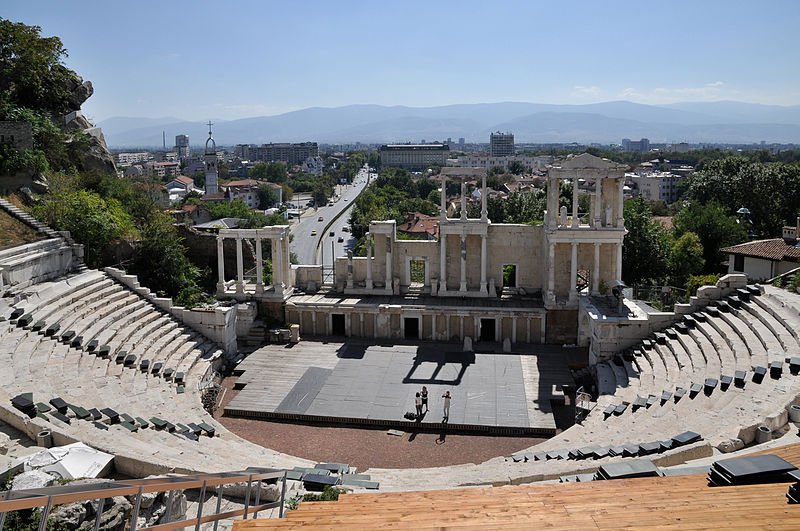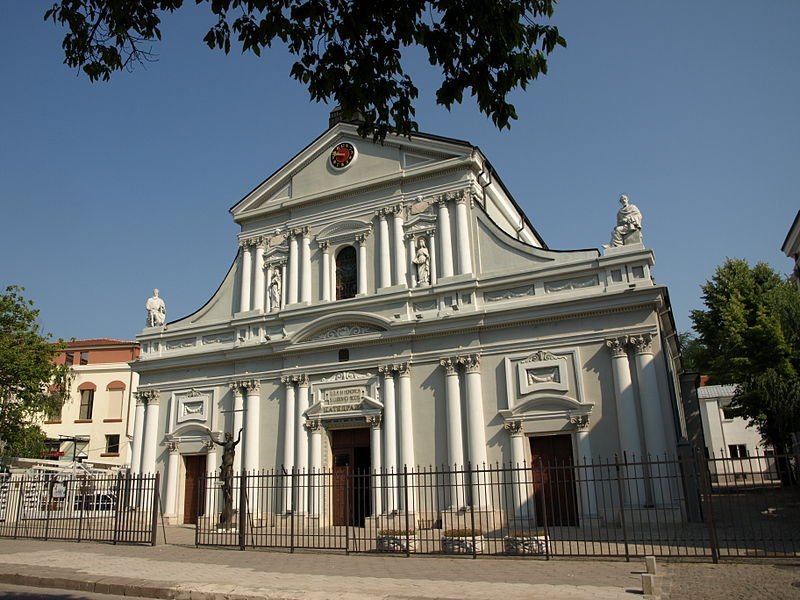 House in Plovdiv, Bulgaria
House in Plovdiv, BulgariaSource: https://commons.wikimedia.org/wiki/File:Bulgaria-Plovdiv-03.jpg
Author: Infobgv

Plovdiv (Bulgarian: Пловдив) is the second largest city in Bulgaria and one of the oldest in Europe. Covering 101.98 sq km (39.4 sq mi), it has a population of 338,000 people (2011 estimate), within a metropolitan area of over half a million people in central-southern Bulgaria.
Plovdiv straddles the Maritsa River, about 152 km (94 mi) from Sofia. It occupies the southern part of the Plovdiv Plain. The city experiences a humid continental climate with influences of the humid subtropical climate. Summers are hot and moderately dry while winters are cold and snowy.
July is the hottest month in Plovdiv, registering an average high temperature of 32°C (90°F). January is the coldest month, with average low temperature of -3°C (27°F). June gets the most rain, at 65 mm (2.56 in).
The history of Plovdiv spans some 6,000 years. The area has been inhabited since 4,000 BC, as evidence by the discovery of fine pottery carbon-dated to that period, indicating the existence of a settlement there.
 Roman Theater, Plovdiv
Roman Theater, PlovdivSource: https://commons.wikimedia.org/wiki/File:Roman_Theatre_Plovdiv.jpg
Author: MrPanyGoff

Earliest written document of a settlement there was in the post-Bronze Age, describing a Thracian fortified settlement called Eumolpias. By the 4th century, it has developed into a center for trade. After it was conquered by Philip II of Macedon, Eumolpias was renamed Philippopolis ().
Philippopolis was captured by the Romans under Marcus Lucullus in 72 BC, and returned to Thracian control. In AD 46 it was incorporated into the Roman Empire as the provincial capital of Thrace, and was renamed Trimontium, meaning "City of Three Hills".
By the 6th century, influence of the Romans in Trimontium was ebbing, and the character of the city evolved with influx of Slavs to populate the reion. At that time, it was back to be called Philippopolis by the Byzantine Greeks and Paldin or Plavdiv in Old Bulgarian. The name Philippopolis was in use until the early 20th century, although the Bulgarians by then have been calling it Plovdiv.
 Roman Catholic Cathedral of St Louis, Plovdiv
Roman Catholic Cathedral of St Louis, PlovdivSource: https://commons.wikimedia.org/wiki/File:StLouisPlovdiv.jpg
Author: Maria Kumanova

Visiting Plovdiv
Plovdiv Airport (PDV) is the second biggest airport in Bulgaria. The new terminal building, opened on 1 July 2009, is among the most modern in the country. There are regular flights from London-Stansted by Ryanair. Charter airlines also provide services from Dublin, Katowice, Kiev, London-Gatwick, Minsk, Moscow and Samara, among others.There are regular train services to Plovdiv from Sofia. There are also bus services from Sofia and other major cities in Bulgaria as well as from Istanbul and Bursa in Turkey.
Places of Interest in Plovdiv
- Apteka Hipokrat
Pharmacy Museum providing a glimpse into the history of treating common ailments. - Archaeological Museum
Museum exhibiting the archaeological discoveries and antiquities from around Plovdiv. - Church of Saints Konstantin & Elena
Church with a wealth of frescoes on its front façade as well as in the interior walls. - Church of Sveta Bogoroditsa
An imposing stone Bulgarian Orthodox church. The interior is lavishly ornamented with murals. A pink-and-blue bell tower was added to the church in 1880. - Church of Sveta Marina
Dating back to the 16th century, the present church was built in 1783 after the original was destroyed by fire. Its intricate iconostasis is the main tourist attraction here. - City Art Gallery
Gallery exhibiting the works of local as well as international artists, including a permanent collection of 19th century artwork. - Dzhumaya Mosque
The main mosque for the Muslims in Plovdiv. Inside is a fountain surrounded by four huge columns. The mosque was built during the reign of Sultan Murad I in 1364. - Georgi Bozhilov-Slona Gallery
Gallery celebrating the works of this Bulgarian modernist painter. - Hindliyan House
House of Stepan Hindliyan, a wealthy 19th century Armenian merchant in Plovdiv. It offers a glimpse into his lavish lifestyle. - History Museum
Museum occupying what was originally intended to be the parliament building of Eastern Rumelia, which became defunct when it merged with Bulgaria in 1885. The museum displays weaponry, uniforms, photographs and other documents related to the 1885 unification. - Hristo Danov House
House of the 19th century book publisher who was credited with introducing large-scale publishing of textbooks in the country. The house overlooks the city of Plovdiv. It is an example of the National Revival architectural style. - Icon Museum
Museum displaying a treasure trove of icons collected from churches during the Communist era, now displayed to the public. - Imaret Mosque
Mosque built in 1445 when Plovdiv was under Ottoman rule. It was originally intended to be a shelter for the homeless, which is what Imaret means. - Kuyumdzhiogh House
One of the most beautiful private houses in Plovdiv built in 1847 and today houses the Ethnographic Museum displaying traditional costumes. - Natural History Museum
Museum displaying a collection of stuffed animals from birds to mammals and reptiles. Not all wildlife is local, as it includes an anaconda and an aquarium with live piranhas. - Nebet Tepe
Nebet Tepe or Prayer Hill is highest point in Plovdiv. Today however it is a dilapidated neighborhood. Nonetheless a visit here provides an understanding of its past importance. - Nedkovich House
Built in 1863 as the home of a textile merchant, today it provides a glimpse into the opulent lifestyle of the rich in Plovdiv in the 19th century. - Philippopolis Gallery
Gallery occupying an elegant house. It showcases Bulgarian portraits and landscapes from the late-19th and early-20th centuries. - Roman Stadium
Ruins of the stadium built in the 2nd century AD by the Romans. Today it is a jumble of strewn columns and stones. - Roman Theater
Marble amphitheater overlooking Plovdiv, today still in use for concerts and plays. - State Gallery of Fine Arts
Gallery of 19th and 20th century Bulgarian paintings housed in a grand old school building. - Trakart Cultural Center
Center exhibiting examples of Roman foundation and floor tiles from a 4th century Roman house. The center is located on an underpass which was once a Roman street. - Zlatyu Boyadzhiev House
Home of the famous Bulgarian artist whose works are now on display on the walls here.
 Latest updates on Penang Travel Tips
Latest updates on Penang Travel Tips

Copyright © 2003-2025 Timothy Tye. All Rights Reserved.

 Go Back
Go Back